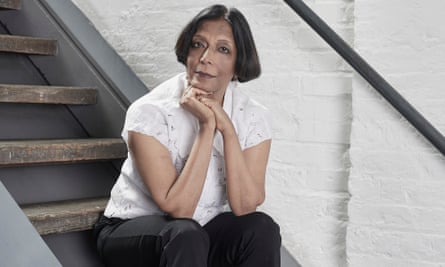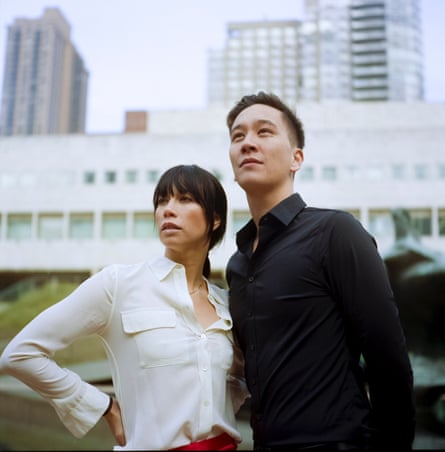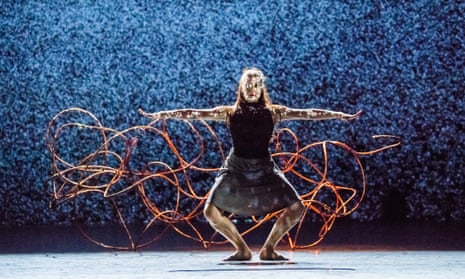A 19th-century worldview informs much of the classical ballet repertoire. Historical ballets are rife with national and racial stereotypes, including the orientalism of La Bayadère, Le Corsaire and Scheherazade, the Chinese (“Tea”) and Arabian (“Coffee”) variations in The Nutcracker, and the character of the Moor in Petrushka, originally played in blackface.
While there has been recent progress (the major UK ballet companies have now revised their Chinese dances and you won’t see blackface on UK stages – although you might in other countries), there remains a seam of stubborn resistance. When I spoke last year to Les Ballets de Monte-Carlo director Jean-Christophe Maillot, he revealed a desire to preserve in aspic not only the steps and costumes of historical ballets, but also the outdated and offensive politics and sensibilities. Alongside that comes an entrenched racism in so-called “traditional” ideas about what certain ballets should look like and who can dance them.
To look deeper into the topic, I talked to dancers and choreographers about ballet’s slow pace of change, which problematic ballets should be thrown out and which ones could be creatively reimagined.
Shobana Jeyasingh, choreographer
Created her own response to La Bayadère, entitled Bayadère – The Ninth Life

When I first saw La Bayadère it made me squirm. It was an embarrassing portrait of India. No matter how many explanatory notes you have in the programme, you experience dance when the lights go down and something moving hits your eye. How can you put all the good intentions and explanations that you signal in the programme into that experience? That discussion is long overdue.
Blackface is still seen in some international versions of La Bayadère. I remember reading an argument against airbrushing such “exotic” aspects of this ballet, saying it was an “instructive reminder of bygone sins”. I find that a very frivolous way of talking about something so huge as slavery and the exploitation of people. I’m offended as a British Asian to sit in an audience and see supposedly Indian holy men [the fakirs] move like servile monkeys.
If many of the 19th-century ballet classics have the same entitled and Eurocentric viewpoint, then this is something that surely has to be tempered. Every branch of the arts has had to engage with the legacy of colonialism, so I don’t see why ballet can’t do the same. I don’t think there’s an easy answer but one has to make a start. The British Museum’s exhibition on orientalism displays contested paintings of eastern women by European artists, but at the end three contemporary Middle Eastern female artists are given the space to respond. One leaves with an understanding of the past and respect for the present.
Shakespeare presents us with similar challenges in Othello, or the compliant woman in The Taming of the Shrew or the conversion of Jewish Jessica at the end of The Merchant of Venice. All these plays have been successfully staged for the modern audience, with its different historical and religious sensitivities, without losing the power of the original text. What is the text of the dance? It’s the choreography, and in Bayadère the tale of love and betrayal. It’s not the harem pants or the orientalism. Surely classical dance can survive without the navel jewels?
La Bayadère is a choreographically robust ballet and the intention is not to vandalise it. I’m not criticising the choreographer, Marius Petipa. He was a man of his time, who did brilliantly well for his time. I would like to think we could do equally brilliantly for our time.
Phil Chan, former dancer, arts educator
Co-founded Final Bow for Yellowface, a campaign dedicated to eliminating outdated representations of Asians on stage

If we only ever see Asians in the media as two-dimensional caricatures, our imaginal worlds become impoverished. Surely, given rich cultures to draw from, we can find better representations?
Georgina Pazcoguin and I founded Final Bow for Yellowface in 2017 after New York City Ballet’s then artistic director Peter Martins called me into his office to see if I had any fresh insights on The Nutcracker. The company received thousands of letters complaining about Nutcracker’s Chinese dance but he didn’t feel it was his work to change [it was created by legendary choreographer George Balanchine].
Is it possible to retain tradition while updating works to be more respectful? Our aim isn’t to call out racist elements in classical ballets, but to spark creative problem-solving. In the Balanchine choreography, a cliche of a Chinaman pops out of a box. What if it was a jumping cricket instead? Crickets are a respectful image from Chinese culture and logically could perform the same choreography, all big jumps. What does it take away? Nothing. We’re not asking companies to redo the whole Nutcracker, or stop doing it altogether. We’re just talking about changing some of the shuffling, head bobbing and gross makeup.
We are actually very conservative in our approach, because we are dancers too. But what we’re saying is that if we don’t change it, if we don’t imagine ways to make these ballets bigger to respond to the world we live in today, they’re going to die.
If you think about what a performing art is, change is an inherent part of it. It’s not fixed like sculpture or painting. The original Black Swan tutu was canary yellow; Giselle had national dances in the second act until Petipa changed it; there are several versions of Balanchine’s Apollo. So if we’re changing some things, why are we are clinging to outdated representations of race?
I’ve developed a tool, a grid with two axes, to help understand potential problems and find solutions. On one axis you have “character” at one end and “caricature” at the other. The second goes from “historical accuracy” to “fantasy”. You could say Madama Butterfly is character, not caricature – Cio Cio San has emotional depth – but it’s also fantasy, it’s not historically accurate. Le Corsaire is also fantasy, but it traffics unflattering tropes of Arabs, so I would say it’s caricature. It’s one way to think about this constructively.

I’m currently working on a new Bayadère with dance scholar Doug Fullington. It’s not set in India but in Busby Berkeley’s Hollywood, so our production will have cowgirls dancing with lassos, but we’re going back to the notations of Petipa’s choreography. My Corsaire, rather than taking place at an Arabian slave bazaar, would be at a children’s dance competition with a director saying: “OK, I’m going to watch 50 kids do crazy variations and pick the best one to join our company.” That’s Corsaire! It takes away the misogyny, the slavery, the orientalism – and you can still put sequins everywhere.
Our message is to think about other ways to do this work for today. Because that’s what good, living art does. What makes a ballet a classic is that it can withstand the warping of time.
Céline Gittens, dancer
Principal, Birmingham Royal Ballet
I performed in Petrushka, in the original format, in my second or third year of the company. I think it was 2007. Being new to the company, my initial thought was: this is theatre, this is what they need to do in order to portray certain characters – they apply makeup to make the Moor black – which is why I never questioned it. I was new, trying to do my job the best I could.
Things have moved on. We’re reassessing everything to be in line with the contemporary world. Blackface is unacceptable. But it’s an interesting conversation to have because otherwise Petrushka is a genuine masterpiece, part of our ballet heritage, but it’s just not acceptable to perform it.
In The Nutcracker, we’ve reconsidered some of the things that are unacceptable. Birmingham Royal Ballet reworked its Chinese variation last year after removing yellow makeup from the costume in 2018. There’s the Arabian dance too – you can’t change one and not the other – and this year BRB have also removed the darker makeup that was once required for the men in the Arabian dance. Having these conversations eliminates the hysteria around change and makes us understand that these things need to be considered.
My whole career has been in England and I have never experienced any discrimination because of my colour. But the same isn’t true for some other dancers in other countries. I’ve seen complaints about dancers not being promoted and so on. At BRB we have quite a diverse company, I think we’re definitely leading the way in that sense.
Ballet was created as a white, elitist art form, but we can’t be boxed in by views from the past. Back then they never would have thought it would touch dancers from the Caribbean, like myself. If you look at the number of countries the dancers in BRB come from, it’s amazing. We’ve grown. And all audiences need to be accepting of the change. We need to be looking at talent, rather than colour.
Georgina Pazcoguin, dancer and campaigner
Soloist at New York City Ballet, aka The Rogue Ballerina, co-founder of Final Bow for Yellowface
I’m Filipino American and I’m the first Asian woman ever promoted out of the corps de ballet at New York City Ballet. I didn’t know how hard this trajectory would be, to push back on a bias held for generations. It has required so much extra work and trauma, I’ve had to prove my talent is undeniable in every aspect.
I’ve had the experience of being made to feel “other”. My first experience of feeling uncomfortable was performing the Chinese divertissement in George Balanchine’s Nutcracker, prior to its recent adaptation. I put on the wig, I was made to accentuate my already Asian features. I was 21 or 22, I didn’t have the wherewithal to explain it, I just knew that this wasn’t right. Certainly at that point nobody could go up to Peter Martins and say: “Excuse me, this is racist.” So I just ended up making a caricature out of the caricature. Everything that was so offensive, the fan, the nodding head, I used humour to deal with it. At one point I bobbed my head so hard I lost my wig.
I’m now known for dancing Coffee, the “Arabian” variation in Nutcracker. How do I feel about that? Depending on which production you’re viewing, it’s a very fine line. It is exoticising, it feeds into orientalism, but the dance can be flipped into a powerful statement about what it is to be a woman. I’ve made it my choice to step into my sensuality and make it athletic, not just sexy. I always feel very empowered when I’m dancing Coffee.
In the past couple of years I’ve been part of the diversity initiative at City Ballet. I want to encourage dancers to find ways to advocate for themselves. Ballet dancers, especially women, are made to feel like we are replaceable. We feel that if we speak up it’s going to be used against us – and sometimes it is. But the more dancers speak up, the more we’re going to change that. You can’t expect someone to grasp your lens of experience, especially when it comes to most white male directors. I say this with utmost respect to men, but the white male gaze has dominated decision-making in the ballet world. We as dancers are accountable for asking questions of our leaders because no matter what our gender or race or intentions, we all have blind spots.
As society’s views change, ballet has to adapt. We’re slow on the uptake in a lot of different ways – our full length ballets mostly feature an outdated power dynamic. It doesn’t take much to remove the offensiveness. There are a lot of traditionalists who think tinkering with anything is blasphemy. But removing brownface from Bayadère is not ruining the ballet. It’s simply employing your suspension of disbelief.
We’re at a breaking point with humanity. We have to really try to see each other. I think ballet is a conduit for inspiring that connection. Even though I’m on stage I have a direct connection to the audience. It’s different to visiting a museum, it’s very much a present art, an actual physical exchange between the dancers and the audience. That’s where the magic of ballet is.
